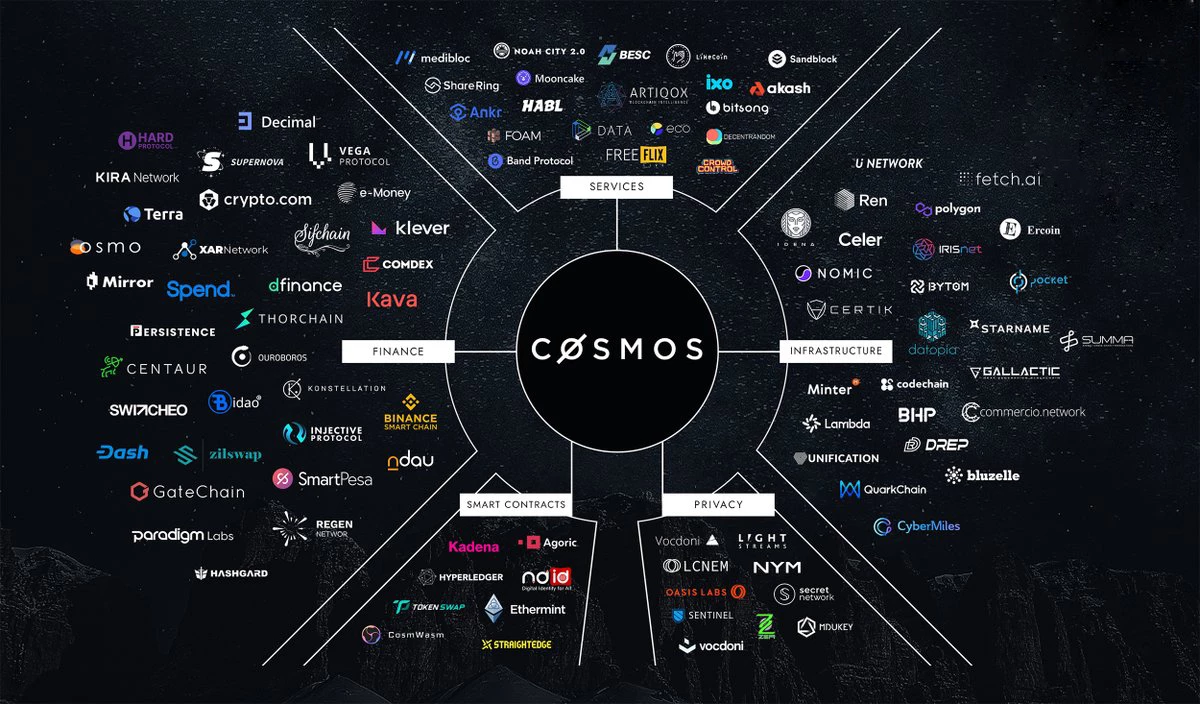Cosmos Ecosystem Blog
In the vast universe of blockchain technology, the Cosmos ecosystem stands out as a constellation of interconnected blockchains, fostering interoperability and scalability. Launched with the vision of creating an Internet of Blockchains, Cosmos has emerged as a promising framework for overcoming the limitations that often hinder the seamless communication between various blockchain networks. In this blog, we'll embark on a journey to explore the Cosmos ecosystem, delving into its core components, principles, and the potential it holds for the future of decentralized applications.
The Cosmos Vision:
The Cosmos project, initiated by Jae Kwon in 2014, envisions a future where different blockchains can communicate and transfer value with ease, creating a truly interconnected web of decentralized applications (dApps). Unlike traditional blockchain networks that often function as isolated islands, Cosmos aims to break down the silos, allowing for the exchange of data and assets across multiple blockchains.
Core Components:
- Tendermint: At the heart of the Cosmos ecosystem is Tendermint, a Byzantine Fault Tolerant (BFT) consensus algorithm. Tendermint ensures secure and consistent state replication across all connected blockchains, providing a robust foundation for the Cosmos Hub and its interconnected zones.
- Inter-Blockchain Communication (IBC): IBC is the protocol that enables communication and interoperability between different blockchains within the Cosmos ecosystem. This innovation allows tokens and data to move seamlessly between disparate blockchains, fostering collaboration and synergy.
- Cosmos SDK: The Cosmos Software Development Kit (SDK) provides developers with the tools to create their customized blockchains, known as zones, within the Cosmos ecosystem. This modular and extensible framework simplifies the process of building and launching blockchains while maintaining compatibility with the broader Cosmos network.
- The Cosmos Hub: Often referred to as the "Internet of Blockchains," the Cosmos Hub is the central hub that connects various zones in the Cosmos ecosystem. It serves as a relay chain for inter-blockchain communication, ensuring the smooth flow of assets and information between different zones.

Use Cases and Applications:
The Cosmos ecosystem opens up a multitude of possibilities for decentralized applications. From finance to supply chain management, and from gaming to identity verification, the interoperability provided by Cosmos allows for the creation of cross-chain applications that leverage the strengths of different blockchains.
- Cross-Chain DeFi: Decentralized Finance (DeFi) applications can benefit significantly from Cosmos by enabling users to access diverse financial services across multiple blockchains. This can lead to increased liquidity, reduced transaction costs, and enhanced financial inclusivity.
- Supply Chain Transparency: Cosmos' interoperability can be leveraged to create supply chain solutions that span multiple blockchains. This ensures transparency and traceability, reducing fraud and errors in the supply chain process.
- Gaming Ecosystem: Cosmos enables the creation of gaming ecosystems that span across various blockchains. Gamers can seamlessly transfer in-game assets and currencies between different games, fostering a dynamic and interconnected gaming experience.
Future Prospects:
As the blockchain space continues to evolve, Cosmos holds the promise of shaping the future of decentralized applications. The ability to connect diverse blockchains, coupled with the robust security provided by Tendermint consensus, positions Cosmos as a key player in the quest for blockchain interoperability.
In the ever-expanding universe of blockchain technology, Cosmos shines as a beacon of interoperability and connectivity. As the Cosmos ecosystem continues to grow and evolve, it paves the way for a new era of decentralized applications that transcend the limitations of isolated blockchains. The Cosmos vision of an interconnected web of blockchains is becoming a reality, offering a glimpse into the potential future of the decentralized digital landscape.













![[LIVE] Engage2Earn: auspol follower rush](https://cdn.bulbapp.io/frontend/images/c1a761de-5ce9-4e9b-b5b3-dc009e60bfa8/1)











![[ℕ𝕖𝕧𝕖𝕣] 𝕊𝕖𝕝𝕝 𝕐𝕠𝕦𝕣 𝔹𝕚𝕥𝕔𝕠𝕚𝕟 - And Now What.... Pray To The God Of Hopium?](https://cdn.bulbapp.io/frontend/images/79e7827b-c644-4853-b048-a9601a8a8da7/1)










